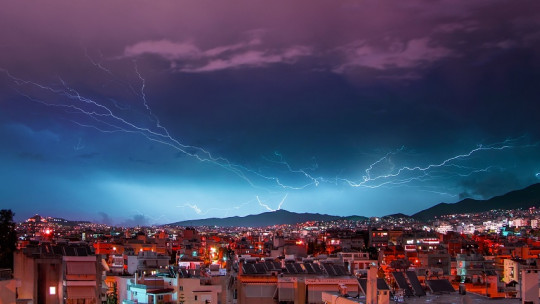
If we set out to make a complete and exhaustive list of all the fears and phobic fears that human beings suffer from, it would be an almost impossible task, since any object or situation is susceptible to becoming a phobic stimulus.
Although some of these fears are easy to recognize, it is quite likely that we have experienced them at some point in our lives, including childhood. Brontophobia is one of these fears that are so common in children but if they are not addressed correctly they can end up taking root in adulthood.
What is brontophobia?
Brontophobia is found within the immense list of specific anxiety disorders and is related to the phobic fear of storms, including thunder and lightning
People who suffer from brontophobia tend to experience an exaggerated, irrational and uncontrollable fear of thunder and lightning, developing an intense anxiety response every time they are exposed to these agents of nature. What causes terror is usually the possibility of being struck by lightning, but there are people who fear other aspects of the storm, such as the danger of too much water falling and collapsing structures nearby or those in which they are at that moment.
As a consequence, this anxiety response tends to give rise to a whole repertoire of behaviors, acts and behavior that are carried out with the intention of avoiding the feared situation or escaping from it as soon as possible.
This phobia It usually has a much higher incidence in boys and girls of younger ages During childhood, experiencing a certain degree of fear of storms is natural, however if this fear intensifies and strengthens over time it can end up becoming a real and intense phobia in adulthood.
Brontophobia can significantly interfere with a person’s life, especially in those situations or locations in which weather conditions favor the origin of thunder and lightning. However, research in psychology has developed a series of highly effective treatments, thanks to which the person can overcome brontophobia and restore normality to their life.
Characteristics of this anxiety disorder
Since brontophobia is part of the category of specific anxiety disorders, it shares symptoms, causes and treatments with them. The most direct consequence of brontophobia is that the person who suffers from it constantly avoids or avoids all those situations or places in which the generation of a storm, lightning or thunder is possible.
Like the rest of specific phobias, brontophobia is characterized by being a phobic fear with a specific aversive stimulus, in this case storms, and which has the following characteristics:
What are the symptoms?
The most distinctive symptom of brontophobia, and the rest of the specific phobias, is the manifestation of high levels of anxiety in the person who suffers from it However, this symptomatology does not have to arise in the same way and with the same intensity in all people.
Even so, for the fear to be classified as phobic, the person must present some of the symptoms of the three categories associated with phobias: physical symptoms, cognitive symptoms and behavioral symptoms.
1. Physical symptoms
Like the rest of the responses related to anxiety, the experience of exacerbated fear usually leads to a series of changes and alterations in the body These changes are caused by the hyperactivity that the autonomic nervous system experiences when the aversive stimulus appears.
This symptomatology includes:
2. Cognitive symptoms
In addition to physical symptoms, brontophobia is accompanied by a series of irrational ideas and distorted beliefs about the phobic stimulus, in this case storms, lightning and thunder. This cognitive symptomatology can manifest itself in the following ways:
3. Behavioral symptoms
Finally, all specific phobias share a series of symptoms or behavioral patterns that appear in response to coping with the phobic stimulus. These behavioral symptoms appear with the aim of avoiding the feared situation, or fleeing when the aversive stimulus has already appeared. These behaviors are known as avoidance or escape behaviors.
Behaviors that aim to avoid encountering a storm, or avoidance behaviors, refer to all those behaviors or acts that the person performs to avoid the possibility of encountering them. In this way it momentarily avoids experiencing feelings of anguish and anxiety that generate these environmental conditions in the person.
On the other hand, escape behaviors appear when the person with brontophobia is already immersed in the feared situation. During this period of time, the person will carry out all types of acts or behaviors that allow them to escape from the situation as quickly as possible.
What causes this phobia?
At the moment, no evaluation techniques or methods have been developed that allow us to completely reliably know the origin of a phobia. On many occasions the person is not aware of the reason for this fear, and is not able to associate it with any experience.
In any case, due to the common components that exist between phobias, it is estimated that the causes of these may be common. Therefore, a possible genetic predisposition to the harmful effects of stress accompanied by the experience of a highly traumatic situation or one with a lot of emotional content and related to storms, can lay the foundations for the development of this and any phobia.
However, there are other factors to take into account such as personality, cognitive styles or learning by imitation, which can favor the appearance and development of irrational fear of any type of object or situation.
- Related article: “What is trauma and how does it influence our lives?”
Are there treatments?
As mentioned previously, brontophobia can be highly disabling, especially in those climates that favor the appearance of storms, so the person can see their daily life conditioned by the appearance of these phenomena, as well as the wear and tear that they cause. It means constantly enduring the high levels of stress it causes.
Fortunately, there is the possibility of approach the disorder from psychotherapy Throughout research, it has been proven that cognitive-behavioral therapy obtains fantastic results in the treatment of phobias.
In these cases, a series of techniques are carried out that aim to reduce and eliminate the three groups of symptoms. Through cognitive restructuring, the aim is to modify those irrational beliefs that the person has regarding storms.
Regarding physical and behavioral stimuli, practices such as systematic desensitization or live exposure, accompanied by training in relaxation techniques They have turned out to be of great help.
These types of techniques applied to patients throughout sessions held on a weekly basis help the person with a phobia of storms overcome their fear by, little by little, associating those feared stimuli with the experience that nothing bad is happening. It begins with the easiest situations to face and ends with those that constitute a greater challenge, following a smooth but constantly rising difficulty curve.
Therefore, the combination of all these techniques will help the person be able to overcome their phobic fear and rebuild their life in a normal way.
- American Psychiatric Association (2013), Diagnostic and Statistical Manual of Mental Disorders (5th ed.), Arlington: American Psychiatric Publishing.
- Craske, M.; Martin MA; Barlow, D. H. (2006). Mastering your fears and phobias. US: Oxford University Press.
- Whalen, P.J.; Phelps, E. A. (2009). The Human Amygdala. New York: The Guilford Press.
- Hamm, A. O. (2009). Specific phobias. The Psychiatric Clinics of North America. 32(3): pp. 577 – 591.








